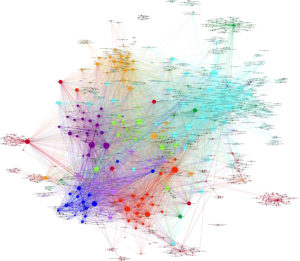
Why is AI important in evaluating data?
Finding the proverbial needle in a haystack

There is a great scene in the television show, The West Wing, where Deputy Chief of Staff Josh Lyman tasks his assistant Donna Moss with finding an old memo written by the President. She subsequently spends the entire episode digging through boxes in a desperate, almost futile search for the document.
I can relate to that as early on in my career I was given the assignment of finding a file in a room. It was an important, but lost document and was swallowed up in a sea of boxes. The task was a tedious one and one I would hope to never replicate.
I have found myself reflecting on this moment and using it as an illustration when I am asked the question of why AI is an instrumental element in the evaluation of big data. The importance of big data has long been established. So much so that businesses are all building a strategy around big data and it’s use into their marketing plans. However, many of the data companies in the market are simply list providers. You are given an abundance of data without any tangible market value.
So why is AI necessary?
Machine learning can do what no human is capable of, which is comb over an abundance of data at exponential speeds. Still there is often an insistence that human evaluation of data is just as effective. But the reality is that the process for analyzing massive amounts of data is a mundane task and it can cause a person to get bored quickly. According to a 2018 MIT study, human beings only process data at 60 bits per second. As a result, we utilize rules of thumb, assumptions and pattern recognition to help draw conclusions from the limited data we can cognitively process.
AI plays an instrumental role in the development of data engineering and analytics and it’s primarily due to its ability to learn just like humans. It addresses shortcoming of tiredness and lack of challenging tasks by being able to consistently draw out conclusions from varying data. AI is not intimidated by large sums of data. Rather, it only gets stronger as the amount increases because it continues to learn and add to its knowledge.
 However, unlike a human, computers work in reverse by first crunching large amounts of data and only at the end, drawing a conclusion. From there these conclusions can be programmed into operative rules that can be applied to further future data sets. By this method they are learning the relationships between different attributes. Naturally, as time progresses and steps are created, a framework is being established today that offers a device wherein AI software can be applied and given a head start to analysis. In effect, AI will teach itself to problem solve and discover based on the mapping already laid out by the computer engineering. As AI gets better at understanding the number they will be able to establish relationships out of the dataset which we, humans would never have found. In this way, the non-biased AI can do work to a huge advantage over humans.
However, unlike a human, computers work in reverse by first crunching large amounts of data and only at the end, drawing a conclusion. From there these conclusions can be programmed into operative rules that can be applied to further future data sets. By this method they are learning the relationships between different attributes. Naturally, as time progresses and steps are created, a framework is being established today that offers a device wherein AI software can be applied and given a head start to analysis. In effect, AI will teach itself to problem solve and discover based on the mapping already laid out by the computer engineering. As AI gets better at understanding the number they will be able to establish relationships out of the dataset which we, humans would never have found. In this way, the non-biased AI can do work to a huge advantage over humans.
Of course, when AI comes into the conversation there is always the fear of what this means for people and jobs. Will AI take the place of a human? A human touch will still be required because as great as AI is, there will still be need for decision making skills in the market. The ability to make emotional and sentiment-based decisions will keep the role of these types of jobs in the hands of humans. In fact, according to LinkedIN, there’s a steady demand for jobs in the field of data engineering and analysis and the World Economic Forum states this demand is only growing.
Working better together
 What this means is that all of these are better together,not just AI and big data, but also the human element. Each one brings a unique aspect and core strength to the table that unlocks the power of the other. While humans produce the big data, AI explores the relationships between the numbers and people then apply their higher-level thinking to the evaluated data that is produced by AI, thereby drawing conclusions about what that will all mean. A bit of a symbiotic relationship is at play here.
What this means is that all of these are better together,not just AI and big data, but also the human element. Each one brings a unique aspect and core strength to the table that unlocks the power of the other. While humans produce the big data, AI explores the relationships between the numbers and people then apply their higher-level thinking to the evaluated data that is produced by AI, thereby drawing conclusions about what that will all mean. A bit of a symbiotic relationship is at play here.
Remove one of these pieces, and the relationship falls apart. We struggle to make sense of big data sets, especially in its raw form. AI cannot yet produce reasons why but can help establish patterns. And without big data, we can’t give AI the information it needs to establish the relationships that exist.
So rather than climbing into that storeroom and sifting through the boxes to find that lost memo, consider giving that task to the AI that can comb over the volumes to find the information you seek. With the application of AI and the volumes of data available to us, we now poised to be able to make decisions with a higher degree of accuracy than ever before in history.
From predictive modeling and complicated algorithms to deep learning and artificial intelligence, Likely.AI is a new-age lead generation tool which is changing lead quality expectations by identifying consumers’ likely real estate decisions before their decisions have been made. To learn more, you can contact Likely.AI here.


